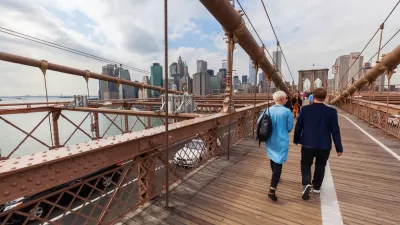For a myriad of personal and professional reasons I moved to New York City this fall. Part of the reason I uprooted myself from the pastel, sun soaked streets of Miami Beach to the chaos of New York is because Gotham has made such incredible strides in becoming one of America's most bicycle-friendly cities.
For a myriad of personal and professional reasons I moved to New York City this fall. Part of the reason I uprooted myself from the pastel, sun soaked streets of Miami Beach to the chaos of New York is because Gotham has made such incredible strides in becoming one of America's most bicycle-friendly cities.
To put things in perspective, New York City has now created enough bike infrastucture to, in aggregate, stretch from my current brownstone apartment in Brooklyn, to my old brownstone apartment in Boston. And while the quantity of bikeways has done much to improve the network, it's the quality and willingness to innovate (you won't find many of the city's bikeway types in the AASHTO "Green Book" or the Manual for Uniform Traffic Control Devices) that has increased cycling and safety for all roadway users.
Last week, however, NYC bicyclists were reminded just how tenuous some of the improvements may be when a 14-block stretch of the Bedford Avenue bike lane was removed by the Department of Transportation. If unfamiliar with Bedford Avenue, it serves as one of the only continuous north-south routes from central Brooklyn to the Williamsburg Bridge, and the Wiliamsburg and Greenpoint neighborhoods--all hotbeds of cycling activity. Interestingly, the stretch of Bedford Avenue where the lane was removed runs directly through a longstanding traditional Hasidic neighborhood whose residents do not all look favorably upon the myriad of secular bike lane users. Indeed, many of the neighborhood's residents did not look favorably upon the bike lane striping in the first place.
In a city where social, economic, political, and religious interests constantly clash over the city's supply of public space, this may not come as a surprise. Yet, the DOT's explanation, that the removal was part of "ongoing bike network adjustments," has been anything but satisfactory to the city's bicycle advocates who contend that not only has a dangerous precedent been set, but that the reasons underlying the DOT's decision are politically motivated and should not dictate the application of safe bikeway infrastructure. Moreover, no description of how the "adjustment" will be carried out is proving frustrating for a bike lane that disappears for 14 blocks.
Since the incident, NYC's livable streets advocates have continued to band together with rallies, letter writing campaigns, and even by re-painting a small portion of lane the in the middle of the night (see YouTube video below). Moreover, Transportation Alternatives, the city's leading voice for all-things bicycling have asked Bedford Avenue bike lane users to continue to use the street to effectively relay the message that bike lane or not, the corridor itself is of great importance to the growing bicycling population.
Streetsblog, Gothamist, the New York Times, and the Twitterati continue to keep close tabs on this issue. Stay tuned as the battle for Bedford Avenue continues...

Alabama: Trump Terminates Settlements for Black Communities Harmed By Raw Sewage
Trump deemed the landmark civil rights agreement “illegal DEI and environmental justice policy.”

Planetizen Federal Action Tracker
A weekly monitor of how Trump’s orders and actions are impacting planners and planning in America.

The 120 Year Old Tiny Home Villages That Sheltered San Francisco’s Earthquake Refugees
More than a century ago, San Francisco mobilized to house thousands of residents displaced by the 1906 earthquake. Could their strategy offer a model for the present?

Ken Jennings Launches Transit Web Series
The Jeopardy champ wants you to ride public transit.

BLM To Rescind Public Lands Rule
The change will downgrade conservation, once again putting federal land at risk for mining and other extractive uses.

Indy Neighborhood Group Builds Temporary Multi-Use Path
Community members, aided in part by funding from the city, repurposed a vehicle lane to create a protected bike and pedestrian path for the summer season.
Urban Design for Planners 1: Software Tools
This six-course series explores essential urban design concepts using open source software and equips planners with the tools they need to participate fully in the urban design process.
Planning for Universal Design
Learn the tools for implementing Universal Design in planning regulations.
Clanton & Associates, Inc.
Jessamine County Fiscal Court
Institute for Housing and Urban Development Studies (IHS)
City of Grandview
Harvard GSD Executive Education
Toledo-Lucas County Plan Commissions
Salt Lake City
NYU Wagner Graduate School of Public Service





























